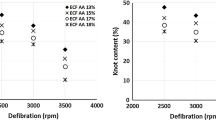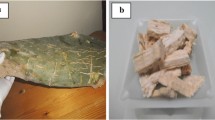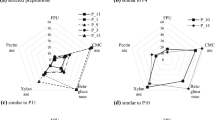Abstract
Four different spruce sulphite pulp samples were used for the preparation of carboxymethylcellulose (CMC). The characteristics of the unreacted fibre and particle residuals obtained in the CMC-preparation were used to establish a correlation between the hemicellulose in the pulp and the intrinsic viscosity, i.e.,␣cellulose chain length and the occurence of unreacted residuals. It was shown that the residual particles in the CMC consisted of fibres, fibre fractions and gel particles of different degrees of substitution. The results suggested that pulps with long cellulose chains, i.e., pulps with high intrinsic viscosities, resulted in particles that were more substituted and more swollen. These pulps also resulted in more substituted hemicelluloses in the CMC and more substituted residuals. It was also suggested that galactoglucomannan in the cellulose pulps is favourable for the swelling which results in more substituted hemicelluloses in the CMC and more swollen residuals. The amount of residuals was influenced mainly by the characteristics of the cellulose in the pulp. It is therefore believed that a combination of high viscosity and a suitable combination of hemicelluloses is the most favourable way of eliminating the occurrence of undissolved residuals in CMC.
Similar content being viewed by others
References
K. Elg-Christoffersson M. Sjöström U. Edlund Å. Lindgren M. Dolk (2002) ArticleTitleReactivity of dissolving pulp: characterisation using chemical properties, NMR-spectroscopy and multivariate data analysis Cellulose 9 159–170 Occurrence Handle10.1023/A:1020108125490
L. Eriksson E. Johansson N. Kettaneh-Wold C. Wikstrom S. Wold (2000) Design of Experiments Umetrics Academy Umeå 60–279
Fälldin A. 2002. Cellulose II in sulfite pulp. Master Thesis, Department of Pulp and Paper Chemistry and Technology, Royal Institute of Technology, Stockholm, Sweden.
L. Grosse W. Klaus (1971) ArticleTitleDie Analytik wasserlöslicher celluloseäther Z. Anal. Chem. 259 195–203 Occurrence Handle10.1007/BF00428439
T. Hausalo (1995) Analysis of Wood and Pulp Carbohydrates by Anion Exchange Chromatography with Pulsed Amperiometric detection, 8th Int. symp. on Wood and Pulping Chem Helsinki Finland
T. Heinze U. Erler I. Nehls D. Klemm (1994) ArticleTitleDetermination of the substituent pattern of heterogenously and homogenously synthesized carboxymethyl cellulose by using high-performance liquid chromatography Angew. Makromol. Chem. 215 93–106 Occurrence Handle10.1002/apmc.1994.052150108
T. Heinze T. Liebert (2001) ArticleTitleUnconventional methods in cellulose functionalization Prog. Polym. Sci. 26 1689–1762 Occurrence Handle10.1016/S0079-6700(01)00022-3
G.C. Hoffman T.E. Timell (1972) ArticleTitlePolysacharides in Ray Cells of Normal Wood of Red Pine (Pinus resinosa) Tappi J. 55 733–736
J. Jansson (1974) ArticleTitleAnalytik der polysacharid in Holz und Zellstoff Faserforshung und Textiltechnik 25 375–382
K. Jardeby H. Lennholm U. Germgård (2004) ArticleTitleCharacterisation of the undissolved residuals in CMC-solutions Cellulose 11 195–202 Occurrence Handle10.1023/B:CELL.0000025390.81603.40
H.A. Krässig (1993) Cellulose–StructureAccesibility and Reactivity Gordon Breach Science Publishers Yverdon, Switzerland 376
J. Kunze A. Ebert H.-P. Fink (2000) ArticleTitleCharacterisation of cellulose and cellulose ethers by means of 13C NMR spectroscopy Cellul. Chem. Tech. 34 21–34
M. Lawoko G. Henriksson G. Gellerstedt (2003) ArticleTitleNew method for quantitative preparation of lignin-carbohydrate complex from unbleached softwood kraft pulp: lignin-polysacharide networks I Holzforschung. 57 69–74 Occurrence Handle10.1515/HF.2003.011
T. F. Liebert T. Heinze (2001) ArticleTitleExploitation of reactivity and selectivity in cellulose functionalization using unconventional media for the design of products showing new superstructures Biomacromolecules 2 1124–1132 Occurrence Handle10.1021/bm010068m Occurrence Handle11777383
M. Marx-Figini (1978) ArticleTitleSignificance of the intrinsic viscosity ratio of unsubstituted and nitrated cellulose in different solvents Angew. Makromol. Chem. 72 161–171 Occurrence Handle10.1002/apmc.1978.050720114
N. Olaru L. Olaru (1992) ArticleTitleMathematical models for the synthesis of carboxymethylcellulose in the isopropyl alcohol system Cellul. Chem. Tech. 26 685–690
N. Olaru L. Olaru (2001) ArticleTitleInfluence of organic diluents on cellulose carboxymethylation Macromol. Chem. Phys. 202 207–211 Occurrence Handle10.1002/1521-3935(20010101)202:1<207::AID-MACP207>3.0.CO;2-Q
Periä O. and Seppä T. 1960. Carbohydrates of Spruce Cells. The Chemical Composition of Wood Cells II. Soumen Kemistilehti, pp. 114.
I. Racz J. Borsa G. Bodor (1996) ArticleTitleCrystallinity and accesibility of fibrous carboxymethylcellulose by Pad-Roll technology J. Appl. Sci. 62 2015–2024 Occurrence Handle10.1002/(SICI)1097-4628(19961219)62:12<2015::AID-APP5>3.0.CO;2-K
I. Racz J. Borsa (1997) ArticleTitleSwelling of carboxymethylated fibres Cellulose 4 293–303 Occurrence Handle10.1023/A:1018400226052
H. Schleicher J. Kunze H. Lang (1988) ArticleTitlePhysikochemische Methoden zur Characteriserung der verarbeitbarkeit von Chemiezellstoffen Zellst. Pap. 37 162–165
J. Schmorak G.A. Adams (1957) ArticleTitleThe preparation and properties of carboxymethylxylan Tappi J. 40 378–383
Schult T., Moe S.T. and Kleppe P.J. 1999. Changes in cellulosic structure during carboxymethylation studied by NMR spectroscopy and X-ray scattering. In: 10th International Symposium on Wood and Pulping Chemistry – 10th Biennial ISWPC – Main symposiumYokohama Japan, p. 180.
E. Sjöström (1993) Wood chemistry – Fundamentals and Application EditionNumber2 Academic Press London 293
J. Stawitz M.P. Kage (1959) ArticleTitleÜber die Quellungsstadien der wasserlöslichen Celluloseäther und die übermolekulare Struktur der Celllose Das Papier 13 567–572
C. Woodings (2001) Regenerated Cellulose Fibres CRC Press USA 130
Author information
Authors and Affiliations
Corresponding author
Rights and permissions
About this article
Cite this article
Jardeby, K., Germgård, U., Kreutz, B. et al. Effect of pulp composition on the characteristics of residuals in CMC made from such pulps. Cellulose 12, 385–393 (2005). https://doi.org/10.1007/s10570-005-2202-3
Received:
Accepted:
Issue Date:
DOI: https://doi.org/10.1007/s10570-005-2202-3




